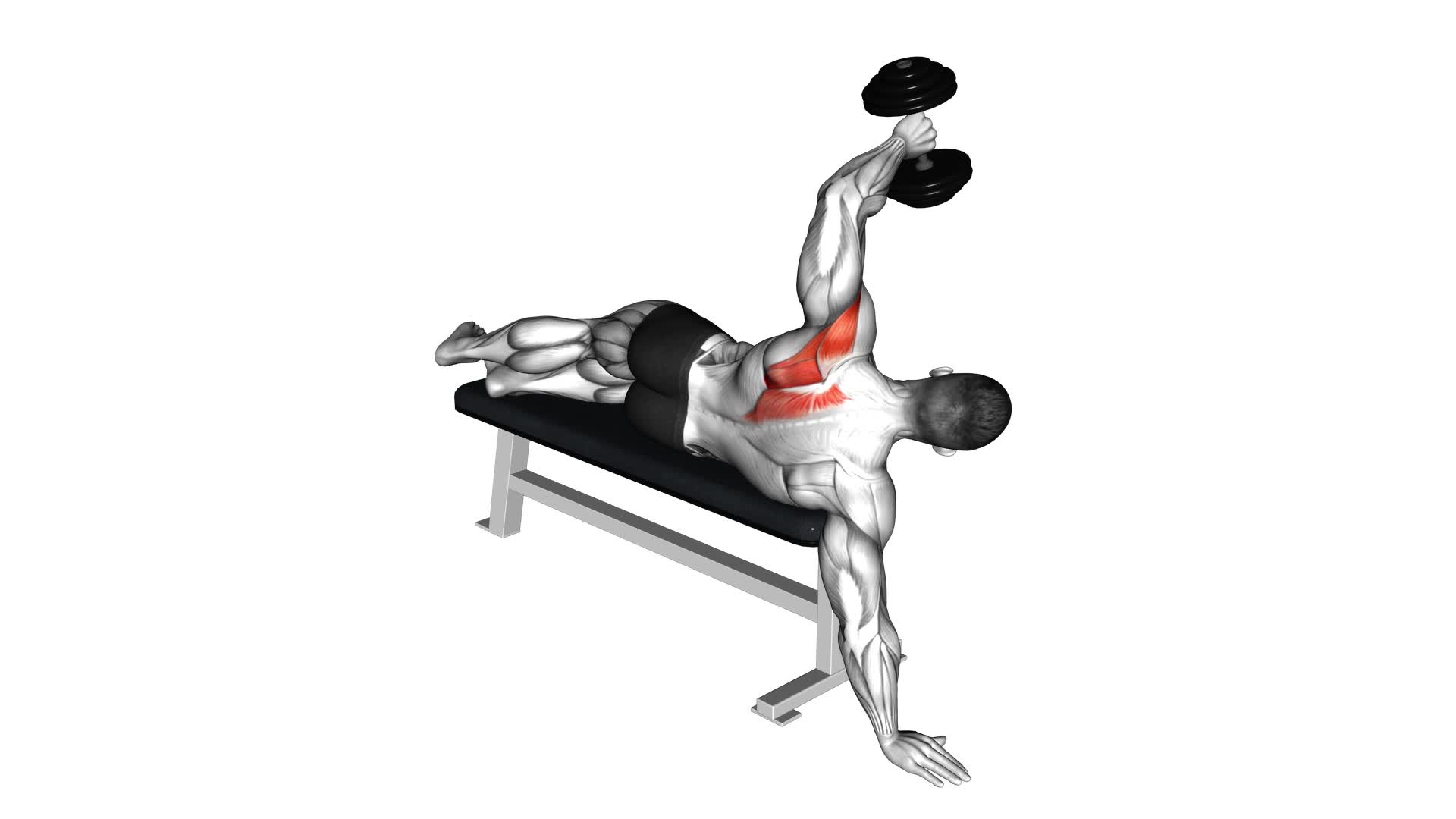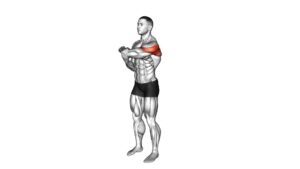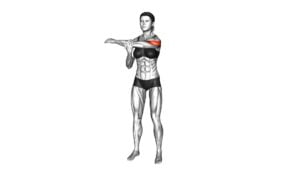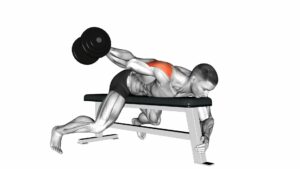Dumbbell Lying One Arm Deltoid Rear – Video Exercise Guide & Tips

Looking to strengthen your deltoids and improve your rear shoulder muscles? Look no further than the Dumbbell Lying One Arm Deltoid Rear exercise.
Watch This Exercise Video
In this video exercise guide, we'll show you the proper technique, common mistakes to avoid, variations to challenge yourself, and tips for incorporating this exercise into your routine.
Get ready to take your shoulder workout to the next level with this effective and targeted exercise.
Let's dive in!
Key Takeaways
- Targets rear deltoid muscle for shoulder stability and strength
- Promotes muscle growth and development
- Enhances muscle activation in rear deltoids
- Reduces risk of shoulder and muscle injuries
Benefits of the Dumbbell Lying One Arm Deltoid Rear Exercise
You should regularly perform the Dumbbell Lying One Arm Deltoid Rear exercise to reap its numerous benefits. This exercise is highly effective in targeting the rear deltoid muscle, which is important for overall shoulder stability and strength. By incorporating variations of this exercise into your routine, you can further challenge your muscles and promote growth.
One variation of the Dumbbell Lying One Arm Deltoid Rear exercise is the single-arm bent-over raise. To perform this variation, start by lying face down on a bench with a dumbbell in one hand, palm facing inwards. With a slight bend in the elbow, raise the dumbbell up towards the ceiling, keeping your arm in line with your body. Lower the dumbbell back down in a controlled manner and repeat for the desired number of repetitions.
To improve shoulder stability during this exercise, it's important to engage your core and maintain proper form. Keep your spine neutral and avoid any excessive arching or rounding of the back. Additionally, focus on squeezing your shoulder blades together as you lift the weight, ensuring that you're targeting the intended muscles.
Incorporating the Dumbbell Lying One Arm Deltoid Rear exercise into your workout routine can lead to improved shoulder strength and stability. By incorporating variations and following proper form, you can maximize the benefits of this exercise for your overall shoulder development.
Proper Technique for Performing the Exercise
To perform the Dumbbell Lying One Arm Deltoid Rear exercise with proper technique, it's crucial to focus on shoulder positioning. Keep your shoulder blades pulled back and down, ensuring proper alignment and engagement of the deltoid muscles. This not only maximizes the effectiveness of the exercise but also helps prevent injuries.
Shoulder Positioning During Exercise
How should your shoulders be positioned during this exercise?
Proper shoulder positioning is crucial for maximizing shoulder mobility and muscle activation during the Dumbbell Lying One Arm Deltoid Rear exercise. To ensure correct shoulder positioning, start by lying face down on a flat bench with one arm hanging down and holding a dumbbell. Keep your shoulders pulled down and back, engaging your shoulder blades. Avoid shrugging or hunching your shoulders.
Throughout the movement, maintain a stable and neutral shoulder position, with the shoulder joint aligned and the upper arm parallel to the floor. This position will help target the rear deltoid muscles effectively and minimize the risk of injury. Remember to focus on maintaining proper form and shoulder positioning throughout the exercise for optimal results.
Benefits of Proper Technique
Maintaining proper technique during the Dumbbell Lying One Arm Deltoid Rear exercise provides numerous benefits for maximizing muscle activation and minimizing the risk of injury. Here are the key advantages of using the correct form:
- Improved Muscle Activation:
Proper technique ensures that the targeted muscles, specifically the rear deltoids, are effectively engaged throughout the exercise. By maintaining the correct form, you can optimize muscle activation, leading to better overall results and muscle development.
- Reduced Risk of Injury:
Following the proper form helps to minimize the risk of injury by ensuring that the load is appropriately distributed and the joints are properly aligned. By using the correct technique, you can avoid putting unnecessary strain on your shoulders and other surrounding muscles, reducing the chance of injury.
Common Mistakes to Avoid
To avoid common mistakes during the dumbbell lying one arm deltoid rear exercise, make sure to maintain the correct positioning of your back.
Keep your spine straight and avoid arching or rounding your back, as this can lead to strain or injury.
Additionally, ensure proper arm alignment by keeping your elbow at shoulder level and avoiding excessive rotation.
Lastly, focus on maintaining shoulder stability throughout the movement to avoid any unnecessary strain on the joint.
Incorrect Back Positioning
You should avoid arching your back during the Dumbbell Lying One Arm Deltoid Rear exercise. Incorrect back positioning can negatively impact your shoulder stability and increase the risk of injury. Here are some common mistakes to avoid:
- Arching your back: Keep your back flat against the bench throughout the exercise to maintain proper alignment and stability.
- Lifting your hips: Avoid lifting your hips off the bench, as it can put excessive strain on your lower back and compromise your form.
Improper Arm Alignment
Avoid arching your back during the Dumbbell Lying One Arm Deltoid Rear exercise, and make sure to maintain proper arm alignment. Improper form and arm alignment can lead to injuries and hinder your progress.
To prevent injury and maximize the effectiveness of this exercise, it's essential to maintain proper arm positioning. Keep your arm straight and in line with your shoulder throughout the entire movement. Avoid letting your arm drift too far forward or backward, as this can strain your shoulder joint.
Lack of Shoulder Stability
Maintain shoulder stability to prevent injuries and maximize the effectiveness of the Dumbbell Lying One Arm Deltoid Rear exercise. Proper shoulder stability is crucial for this exercise, as it requires controlled movement of the shoulder joint.
Here are some common mistakes to avoid:
- Lack of shoulder mobility:
- Limited range of motion in the shoulder joint can lead to compensatory movements and improper form during the exercise.
- Incorporate shoulder mobility exercises, such as shoulder circles or arm swings, into your warm-up routine to improve the mobility of your shoulder joint.
- Neglecting strengthening exercises:
- Weak shoulder muscles can compromise stability and increase the risk of injuries.
- Include exercises like shoulder presses, lateral raises, and rows in your workout routine to strengthen the muscles surrounding the shoulder joint.
Variations to Challenge Yourself
Add intensity to your workout by trying different variations of the Dumbbell Lying One Arm Deltoid Rear exercise. Whether you're a beginner or looking for advanced modifications, there are variations that can challenge you and help you progress in your fitness journey.
For beginners, start by using lighter dumbbells or even water bottles as weights. This will allow you to focus on your form and build up strength gradually. As you become more comfortable with the exercise, you can increase the weight of the dumbbells to further challenge yourself.
Advanced modifications of the Dumbbell Lying One Arm Deltoid Rear exercise include incorporating resistance bands or using an incline bench. Adding resistance bands will increase the tension on your muscles, providing a greater challenge during the exercise. Using an incline bench will change the angle of the exercise, targeting your deltoids from a different position.
By incorporating these variations into your workout routine, you can continuously challenge your muscles and make progress in your fitness goals. Remember to always listen to your body and adjust the intensity as needed.
Now, let's move on to some tips for incorporating the Dumbbell Lying One Arm Deltoid Rear exercise into your routine.
Tips for Incorporating the Exercise Into Your Routine
As you progress in your fitness journey and incorporate variations of the Dumbbell Lying One Arm Deltoid Rear exercise, there are some helpful tips to ensure you effectively integrate this exercise into your routine.
Incorporating modifications:
- Start with a lighter weight: If you're new to this exercise, it's important to begin with a lighter dumbbell to avoid straining your shoulder. As you become more comfortable and confident, gradually increase the weight.
- Focus on proper form: Maintaining proper form is crucial to avoid any unnecessary strain on your shoulder. Keep your back flat against the bench, engage your core, and move your arm in a controlled manner.
Avoiding shoulder strain:
- Warm up before starting: Prior to performing the Dumbbell Lying One Arm Deltoid Rear exercise, it's essential to warm up your shoulder muscles. This can be done through dynamic stretches or light shoulder exercises.
- Listen to your body: If you experience any discomfort or pain in your shoulder while performing this exercise, stop immediately. It's better to take a break and consult with a fitness professional or healthcare provider to ensure you're using proper technique and avoiding injury.
By incorporating modifications and being mindful of shoulder strain, you can effectively integrate the Dumbbell Lying One Arm Deltoid Rear exercise into your routine.
Now, let's move on to the next section where you can watch a video demonstration of this exercise.
Video Demonstration of the Dumbbell Lying One Arm Deltoid Rear Exercise
To further understand the proper execution of the Dumbbell Lying One Arm Deltoid Rear exercise, watch the video demonstration below. In this video, you'll see a trainer performing the exercise step by step, giving you a clear visual guide on how to do it correctly.
The Dumbbell Lying One Arm Deltoid Rear exercise targets the rear deltoid muscles, which are located at the back of your shoulders. It's a unilateral exercise, meaning you work one arm at a time, allowing for better focus and isolation of the muscles.
To perform the exercise, lie face down on a bench with a dumbbell in one hand. Keep your arm extended and parallel to the floor, ensuring a slight bend in your elbow. Engage your core and squeeze your shoulder blades together as you lift the dumbbell up towards the ceiling. Pause for a moment at the top of the movement, then slowly lower the weight back down to the starting position.
Remember to keep your movements controlled and avoid any jerking or swinging motions. Focus on feeling the contraction in your rear deltoid muscles throughout the exercise.
Frequently Asked Questions
What Are the Benefits of the Dumbbell Lying One Arm Deltoid Rear Exercise for Shoulder Strength and Stability?
The dumbbell lying one arm deltoid rear exercise is great for shoulder strength and stability. It helps to target the rear deltoids, which are important for overall shoulder development.
By performing different variations of this exercise, you can challenge your muscles in different ways and prevent plateaus.
Additionally, it's crucial to maintain proper shoulder posture throughout the exercise to avoid injury and maximize the benefits. So, make sure to keep your shoulders down and back, engaging your core for stability.
How Many Sets and Repetitions Should I Perform for Optimal Results?
For optimal results in muscle growth, you should perform 3-4 sets of the dumbbell lying one arm deltoid rear exercise. Aim for 8-12 repetitions per set, using a weight that challenges you but still allows for proper form.
Keep in mind that variations of this exercise, such as using different angles or grips, can help target different areas of the rear deltoid muscle. Experiment with different variations to keep your workouts fresh and effective.
Can This Exercise Be Modified for Individuals With Shoulder Injuries or Limitations?
If you have shoulder injuries or limitations, it's important to modify exercises to avoid further harm.
When it comes to the Dumbbell Lying One Arm Deltoid Rear exercise, there are alternative exercises you can try that are gentler on your shoulder.
By consulting with a fitness professional or physical therapist, they can provide you with specific modifications tailored to your needs.
Remember to prioritize your safety and listen to your body during any workout.
Are There Any Specific Cues or Tips for Maintaining Proper Form Throughout the Exercise?
To maintain proper form during the exercise, it's important to keep a stable core and avoid swinging or using momentum.
Engage your shoulder and focus on squeezing your shoulder blades together at the top of the movement.
Don't let the weight drop too low or go too high, as this can strain your shoulder.
Be mindful of any discomfort or pain and adjust accordingly.
These tips will help you perform the exercise safely and effectively.
How Does the Dumbbell Lying One Arm Deltoid Rear Exercise Compare to Other Shoulder Exercises in Terms of Muscle Activation and Effectiveness?
The dumbbell lying one arm deltoid rear exercise is a great addition to your shoulder workout routine. Compared to other shoulder exercises, this exercise provides excellent muscle activation in the rear deltoids.
It's an effective way to target and strengthen this specific muscle group. Incorporating this exercise into your routine will help you achieve a well-rounded shoulder development and improve your overall upper body strength.
Conclusion
In conclusion, the dumbbell lying one arm deltoid rear exercise is a great way to target and strengthen your rear deltoid muscles. It offers numerous benefits, including improved shoulder stability and posture.
By following the proper technique and avoiding common mistakes, you can ensure maximum effectiveness and avoid injury.
To challenge yourself, try incorporating variations of the exercise into your routine.
This exercise is a valuable addition to any upper body workout.

Author
Years ago, the spark of my life’s passion ignited in my mind the moment I stepped into the local gym for the first time. The inaugural bead of perspiration, the initial endeavor, the very first surge of endorphins, and a sense of pride that washed over me post-workout marked the beginning of my deep-seated interest in strength sports, fitness, and sports nutrition. This very curiosity blossomed rapidly into a profound fascination, propelling me to earn a Master’s degree in Physical Education from the Academy of Physical Education in Krakow, followed by a Sports Manager diploma from the Jagiellonian University. My journey of growth led me to gain more specialized qualifications, such as being a certified personal trainer with a focus on sports dietetics, a lifeguard, and an instructor for wellness and corrective gymnastics. Theoretical knowledge paired seamlessly with practical experience, reinforcing my belief that the transformation of individuals under my guidance was also a reflection of my personal growth. This belief holds true even today. Each day, I strive to push the boundaries and explore new realms. These realms gently elevate me to greater heights. The unique combination of passion for my field and the continuous quest for growth fuels my drive to break new ground.







